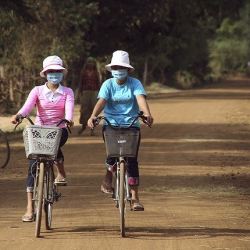My inner engineer tells me that air sampling for biologics, especially COVID-19, may be an important way to help measure and contain the pandemic and opening up.
“Testing” has become the motto in the fight against COVID-19. Tens of millions of tests have been done in the U.S., each comprising analysis of an individual biological sample with a dichotomous outcome: COVID-19 present (positive) or not (negative, which is the overwhelming result). A positive response is interpreted as an infected individual. Such a classic medical diagnostic approach cannot describe the nature of the positive cases, for example, the magnitude of the viral load indicating the possible severity and transmissibility of the disease.
Dose-response relationships are required to devise effective abatement strategies. Our growing testing archive tells us about numbers of cases but nothing about the doses per se. Similarly, reviewing hospital data, we learn a lot about patient risk but are left only with inference about the exposure that resulted in their infection. Dose-exposure responses become more critical as the virus persists in the environment, as now seems to be the case. We know that crowds can be a source of virus transmission, but we remain unsure about relevant mechanisms.
The broader scientific community has begun to recognize the importance of airborne virus transmission despite reservations from the World Health Organization. This prompts comparisons with our knowledge of the health effects of non-biological air pollution. Traditionally, sources like powerplants and vehicles are identified, and their outputs of various pollutants are measured or estimated. The airborne viral source counterpart is the exhaled breath of infected individuals that must be sampled for viral content to confirm the likelihood of airborne transmission.
Air quality studies use mathematical models to translate outdoor atmospheric loads of air pollution to presumptive exposures. Air sampling and monitoring stations are set up to validate them and to determine whether health-based air quality standards are being met. Like our current COVID-19 testing, this regulatory paradigm provides a dichotomous yes-or-no tally.
Individual COVID-19 tests are sporadic spot samples with no permanent value, but a suitable continuous monitoring device could produce a location-specific history of viral loads useful in measuring dosage and response. Given the 130,000 U.S. schools to be reopened, about 200,000 indoor locations might be candidates for continuous viral air monitoring, about 1% of the current total of individual tests. Portable monitoring devices could assess viral conditions in mass gatherings. Such hardware would be one-time purchases. For comparison, there are more than 38 million indoor carbon monoxide monitors installed in the U.S. in continuous operation.
The emission rate of viruses from human respiration may be the key to understanding COVID-19 transmission and infection. Indoor viral concentration data can describe residences, businesses, group venues such as theaters, churches, arenas, before, during, and after human occupation. The performance of various types of air-filtering devices in theaters and arenas could be evaluated. Outdoor air concentration data could evaluate the 6-ft social separation rule and the implied hazards of congregate settings like sporting events and beach parties. Unlike negative coronavirus results, all air sampling results would be useful. The combinations of data on individual status, viral load, and environmental conditions are the ultimate goal for devising methods for accommodating life with the virus.
This proposition presents a new pandemic paradigm and an important departure from traditional medical practices. However, biological air sampling has been an important part of many research programs [1,2], including one that included the New York City subways [3].
I have no idea as to the practical limitations of implementing widespread airborne virus monitoring and measuring low virus concentrations, having devoted my professional life to numbers rather than hardware or biology. However, my inner engineer tells me that the tremendous efforts dedicated to accelerated manufacturing of personal protection devices, ventilators, and vaccine development could be expeditiously focused on such a program.
Epidemiologists have laid the groundwork for combating this virus; now give environmental engineers a chance!
[1] Shotgun Transcriptome and Isothermal Profiling of SARS-CoV-2 Infection Reveals Unique Host Responses, Viral Diversification, and Drug Interactions. Version 5. bioRxiv [Preprint]. 2020 DOI: 10.1101/2020.04.20.048066.
[2] Sampling and detection of coronaviruses in air: A mini-review. Sci Total Environ. DOI: 10.1016/j.scitotenv.2020.140207
[3] Air Microbiome and Pollution: Composition and Potential Effects on Human Health, Including SARS Coronavirus Infection. J Environ Public Health. DOI: 10.1155/2020/1646943.
